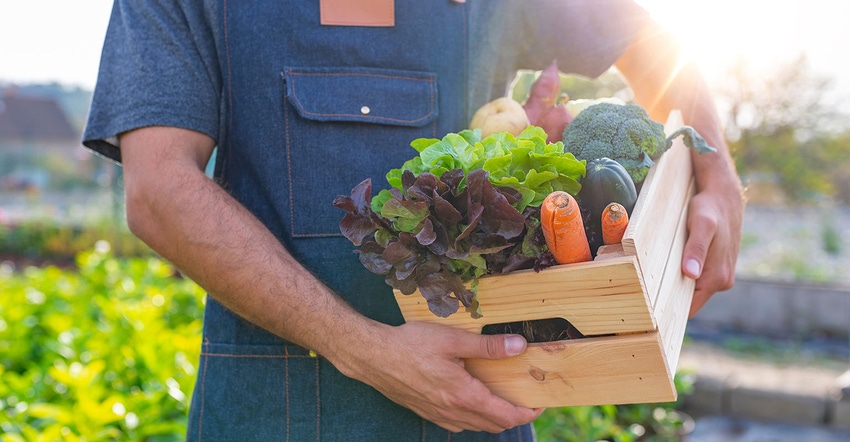Resource-efficient ingredients, methods color today’s most successful ecological ventures
Environmental issues are among humanity’s most significant challenges, but companies like Cargill and ADM are using corporate policy and new technologies to forge a more sustainable food industry.

At a Glance
- Nearly three-quarters of consumers globally are concerned about environmental issues.
- Sustainable food companies face hurdles due to sourcing ingredients from around the world.
- New food technologies may hold the answer, such as a Michroma’s color-creating precision fermentation process.
Scarcely a day goes by without an alarming news story about fire, flood or overwhelming heat. The fragility of the earth is in focus. So is the need to sustain our resources.
“More than ever, consumers are concerned about the state of the environment, with 74% of global consumers sharing this concern,” said Sam Minaradi, VP of marketing, ADM. Citing data from FMCG Gurus, he added, “Survey respondents stated that carbon emissions, global warming, plastic pollution, food waste and deforestation are the top five areas of concern.”
While individual action is important, the same report indicated many consumers also hold companies responsible for sustainability. “Globally, 66% of consumers stated that food, drink and supplement brands should be doing more to protect the planet,” Minaradi continued. “And while there is still uncertainty from consumers on certain claims being made, manufacturers are starting to garner consumer trust, with research showing that 42% of global consumers have become more trusting of environmental claims made by brands in the last two years.”
Agriculture
Crops are the heart of the world’s food supply. “The agricultural sector is the second-largest source of greenhouse gas emissions globally, and farming of sugarcane, palm oil and soybean oil has been linked to forced and child labor issues,” said Darien Holman, sustainability specialist at ingredient supplier Corbion. “Sustainable agriculture, however, has the potential to protect the planet, enhance the economic viability of the agricultural sector, and support the livelihoods and well-being of farmers and the communities they work in. Growing practices in many areas of agriculture are involved with protecting biodiversity; eliminating deforestation; ensuring stewardship of the air, soil and water; and mitigating climate change.”
Building relationships with farmers and supporting their responsible production practices is a crucial step toward transparency and responsible sourcing. Michelle French director of global sustainability programs at ingredient supplier ADM, stated, “Through our re:generations program, we provide technical assistance and direct payments to help farmers implement regenerative agriculture practices, including cover crops, conservation tillage and fertilizer efficiency.”
ADM uses trademarked names to communicate sustainable ingredient lines. HarvestEdge flours and sorghums are sourced from farmers implementing regenerative agriculture practices. Flour is made at one of the company’s net carbon-neutral mills. And the company said its proprietary SustainMINT disease-resistant mint plants enable reduced agricultural inputs of water, pesticides and herbicides—and that these reductions may help reduce the environmental impact of crop production, such as greenhouse gas emissions and soil erosion.
Cynthia Morphet, QA (quality assurance) certifications and customer support manager at ingredient supplier Global Organics, emphasized that organic agriculture is the standard for sustainability. “It limits the use of chemicals and synthetic inputs and encourages practices that restore the health and vitality of the soil. Regenerative agriculture takes the organic standards a step further, encouraging practices that also increase biodiversity, and address the health and welfare of livestock.
Sustainability can be a challenging undertaking for companies like Global Organics because they procure large numbers of ingredients from around the globe. The company’s suppliers are primarily located in Central and South America, Asia and Europe. “One of the challenges in supporting and choosing sustainable ingredients from other countries is the need to ensure that sufficient quantities of ingredients will be available,” Morphet explained. “We also need to be able to provide support to suppliers so that they can achieve and maintain the certifications that will help them achieve a sustainable future.” The company requires organic certification for the ingredients they sell, and they also evaluate the suppliers’ practices against other standards that address additional aspects of sustainability such as labor and the environment.
James Ede, a sustainability lead at Cargill for starches, sweeteners and texturizers, pointed out that some crop production systems require more resources than others. “We believe agriculture is how we will reduce and mitigate the impacts of climate change,” he said. The company’s RegenConnect program helps farmers adopt sustainable agricultural practices.
The Cargill Cocoa Promise, launched in 2012, touches the lives of approximately 250,000 farmers, spans six cocoa-producing countries and encompasses more than 100 collaborative projects, aimed at addressing some of the biggest environmental, social and economic challenges facing the cocoa sector.
“As part of this effort, we are working to ensure deforestation is eradicated and helping cocoa farmers adopt sustainable practices, such as increasing on-farm tree cover, with the aim of fostering sustainable landscapes that balance cocoa production and forest conservation,” said Kate Clancy, group sustainability director at Cargill cocoa & chocolate. “Environmental efficiencies are also evident in our cocoa-processing facilities, many of which are powered by renewable wind and solar energy.”
Certifications
Third-party certifications are important in determining the integrity of agricultural ingredients. Organic standards accepted globally include the USDA National Organic Program (NOP), the Canadian Organic Regime (COR) and the EU Organic Standard (EOS). Regenerative Organic Agriculture (ROA) is a recent standard becoming more well known globally. The Sustainable Food Group’s Sustainability Standard, launched in 2021 as the result of a collaborative effort involving the Sustainable Food Group, Primus Auditing Operations, and Azzule. Universal standards are also available for fair trade, including Fairtrade International (FLO), Fair Trade USA, and Fair for Life. Additionally, various ISO standards address environmental and management sustainability.
Corbion relies on certifications such as Bonsucro, Roundtable for Sustainable Palm Oil (RSPO), and Proterra because the company is not directly involved with the growing, harvesting and processing of its key ingredient offerings. The company sources sugarcane, corn, palm oil, soy and wheat from all over the world, but a vast majority comes from Thailand, Brazil, the United States and the EU, according to Holman. “Corbion's cane sugar policy defines the specific requirements for production of sustainable cane sugar, based on the definitions for sustainable sugarcane and derived products as set out by Bonsucro,” Holman stated. The company encourages all its cane sugar suppliers to work toward the full implementation of that standard. Bonsucro is a global nonprofit, multi-stakeholder organization founded by the World Wildlife Fund (WWF) in 2005 to advance more economically, environmentally and socially responsible sugar production.
Corbion’s palm oil statement describes the company’s requirements for responsible sourcing of palm, including no deforestation, no peat and no exploitation. The company’s statement on soy describes its sourcing and engagement around this commodity.
Cargill’s Palm Sustainability Policy has been in place since 2014, yet it continues to evolve. “We have a clear sustainability strategy in place, which builds on our global sustainability priorities,” said Catalina Roman, sustainability lead of Cargill’s global edible oil solutions, North America. “In 2021, we substantially expanded our offering of segregated palm oil certified by the RSPO. One year later, we expanded our segregated palm oil offerings to include palm olein and palm stearin. By late 2023, our palm flows in North America will be 100% RSPO certified.”
The company is also proud of the work it’s done within its stevia product line to promote sustainable sourcing. “When Cargill entered the stevia market more than a decade ago, we built the industry’s first stevia sustainability standard,” Ede maintained. “More recently, we became the first stevia supplier to have our entire grower network benchmarked at Silver Level by the SAI [Sustainable Agriculture Initiative] Platform’s Farm Sustainability Assessment [FSA].”
A colorful example
While impossible to cover the breadth of ingredients available to food developers, looking at colors illustrates the necessity to question sustainability. Juan Pablo Orlov, chief of staff at biotech platform Michroma, believes many consumers aren’t aware that colors are often produced using petroleum-based derivatives. “Fewer people realize that natural replacements can also have high water consumption, land use, and reliance on pesticides and herbicides.” He said Michroma is on a mission to meet the demand for truly sustainable alternatives.
The company creates colors using filamentous fungi through a precision fermentation process. “Our approach leverages the advantages of fungi as efficient microorganisms for producing small molecules,” Orlov said. “Compared to other organisms used in fermentation processes, fungi offer greater sophistication and potential for creating a wide range of colors at an incredibly high yield.”
Michroma uses clean agro-industrial waste as feedstock in its fermentation process, helping address a problem for other industries while reducing production costs. Compared to other natural colorants, the company said its process uses a smaller fraction of water. And because precision fermentation requires minimal space in contrast to the necessary arable land employed in many alternative natural colorants, the land use has the potential to be more efficient as well.
Certain colors, such as Red No. 3 and titanium dioxide, are under regulatory scrutiny. “Red+ [the company’s alternative solution] is comparable and a viable substitute for red dye No. 3,” Orlov said, adding that his company is also working on a white colorant using the platform.
Measuring success
Fermentation is behind Cargill’s EverSweet stevia sweetener as well. “This enables commercial-scale production with a dramatically lower carbon footprint and a significant reduction in water resources than other biological-based sweeteners,” Ede claimed. “To quantify the benefits, we recently completed a new life cycle assessment for EverSweet, the second such analysis completed in the span of just two years. It found that EverSweet uses 98% less water and produces 83% less carbon dioxide than sugar. The fermentation-derived sweetener also offers an impressive advantage over other stevia production methods, including Reb (Rebaudioside) M sweeteners produced through bioconversion. Perhaps most surprising was how well EverSweet stacked up to artificial sweeteners, which are produced through highly efficient chemical synthesis. While EverSweet relies on biological materials and processes, we found it delivered results that were nearly identical to synthetic sweeteners like sucralose.”
Using these findings, Cargill plans to soon help customers translate their sustainability goals into action, aided by an easy-to-use resource. “This digital tool will allow customers to instantly calculate the impact EverSweet has on key sustainability metrics. Users will enter their sugar-reduction goals and current sweetener solution; Cargill’s Sustainability Calculator will highlight potential savings in water use, carbon footprint reductions and other environmental criteria.”
About the Author(s)
You May Also Like






